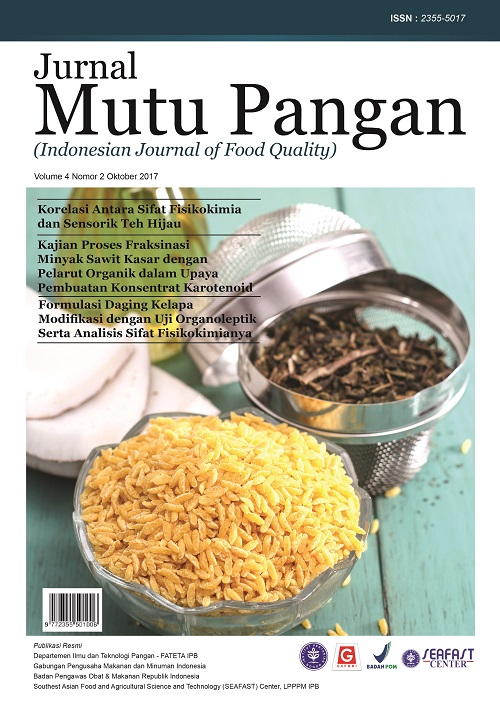Korelasi Antara Sifat Sensori dan Fisikokimia Teh Hijau
Abstract
. This research aimed to study the physicochemical properties especially phenolic content and color, sensory properties), and correlation between those parameters with sensorial properties of green teas from in different countries (Thailand, China, Indonesia, and Japan). The phenolic content was analyzed by the spectrophotometer. Color was analyzed by Chromameter using a white tile (D6:Y=94.4, x=0.3172, y=0.3339). The sensory properties for some sensory attributes of green tea (bitter taste, burn odor, fermented odor, astringency, and green odor) was performed by using quantitative descriptive analysis (QDA) method. The greatest amounts of total phenolic content (952.46 mg GAE/100 mL) were found for green tea leaves from Thailand (Am Nouy). The lowest amounts of total phenolic content were found from another tea samples with values ranging from 122.83 mg GAE/100 mL. The lowest color values of a* coming from Wawee Nature Group (-8.52) whereas the highest color value of a* was from Chanya (6.41). For Quantitative descriptive analysis, the burned fermented and aroma dry is teh Hijau Asli GMQ 2, Tong Tji, Chanya, Kepaladjenggot. Green and bitter is Teh Hijau Asli GMQ 1, Am nuoy, Royal project (TH), Wawee tea (TH), and Sencha. The positively correlation was found between bitter taste with green aroma, and b*; fermented with burned and aroma dry; dry aroma with burned and b*. The negatively correlation was found between burned aroma with total phenolic content and L*.
Downloads
References
Anjarsari IRD. 2016. Katekin teh Indonesia: prospek dan manfaatnya. Kultivasi 15(2): 99-106. DOI: 10.2 4198/kltv.v15i2.11871.
Bancirova M. 2010. Comparison of the antioxidant capacity and the antimicrobial activity of black and green tea. Food Res Int 43: 1379-1382. DOI: 10.1016/j.foodres.2010.04.020.
Borneo R, Leon EA, Aguirre A, Ribotta P, Cantero JJ. 2009. Antioxidant capacity of medicinal plants from the Province of Cordoba (Argentina) and their in vitro testing in model food system. Food Chem 112: 664–670. DOI: 10.1016/j.foodchem.2008.06.027.
Chupin L, Motillon C, Bouhtoury FCE, Pizzi A, Charrier B. 2013. Characterisation of maritime pine (Pinus pinaster) bark tannins extracted under different conditions by spectroscopic methods, FTIR and HPLC. Ind Crops Products 49: 897-903. DOI: 10.1016/j.indcrop.2013.06.045.
El-Daly. 2011. The protective effect of green tea extract against enroflaxin action on the rat liver: histological, histochemical, and ultrastructural studies. J Am Sci 7(4): 669-679.
Esbensen KH. 2004. Multivariate Data Analysis in Practice. An Introduction to Multivariate Data Analysis and Experimental Design, fifth ed. CAMA Process AS, Oslo (Norway).
Green BG, Schullery MT. 2003. Stimulation of bitterness: differences between lingual areas innervated by the glossopharyngeal and chorda tympani nerves. Chem Senses 28: 45-55. DOI: 10.1093/chemse/28.1.45.
Huang WY, Cai YZ, Zhang Y. 2009. Natural phenolic compounds from medicinal herbs and dietary plants: potential use for cancer prevention. Nutr Cancer 62: 1–20. DOI: 10.1080/01635580903191585.
Kim ES, Liang LR, Jin J, Sun QF, Lu JL, Du LL, Lin C. 2007. Impact of heating on chemical compositions of green tea liquor. Food Chem 103: 1263-1267. DOI: 10.1016/j.foodchem.2006.10.031.
Marnewick JL, Rautenbacha F, Venterb L, Neethlinga H, Blackhurstc DM, Wolmaransd P, Machariaa M. 2011. Effects of rooibos (Aspalathus linearis) on oxidative stress and biochemical parameters in adults at risk for cardiovascular disease. J Ethnopharm 133: 46–52. DOI: 10.1016/j.jep.2010.08.061.
Mitsuru M, Michael NOG, Kerry JP, Buckley DJ. 2005. Addition of tea catechins and vitamin C on sensory evaluation, colour and lipid stability during chilled storage in cooked or raw beef and chicken patties. Meat Sci 69(4): 773-779. DOI: 10.1016/j.meatsci.20 04.11.010.
Shishikura Y, Khokhar S. 2005. Factors affecting the levels of catechins and caffeine in tea beverage: Estimated daily intakes and antioxidant activity. J Sci Food Agr 85: 2125-2133. DOI: 10.1002/jsfa.2206.
Szkudlarz SM, Wojtasiak RZ, Szwengiel A, Pacynski M. 2011. Use of grape by-product as a source of dietary fiber and phenolic compounds in sourdough mixed rye bread. Int J Food Sci Technol 46: 1485-1493. DOI: 10.1111/j.1365-2621.2011.02643.x.
Stagos D, Amoutzias GD, Matakos A, Spyrou A, Tsatsakis AM, Kouretas D. 2012. Chemoprevention of liver cancer by plant polyphenols. Food Chem Toxicol 50: 2155-2170. DOI: 10.1016/j.fct.2012. 04.002.

















